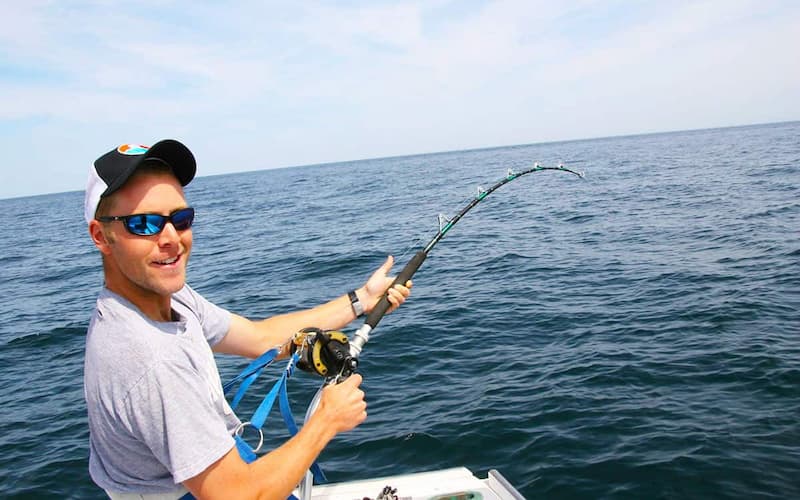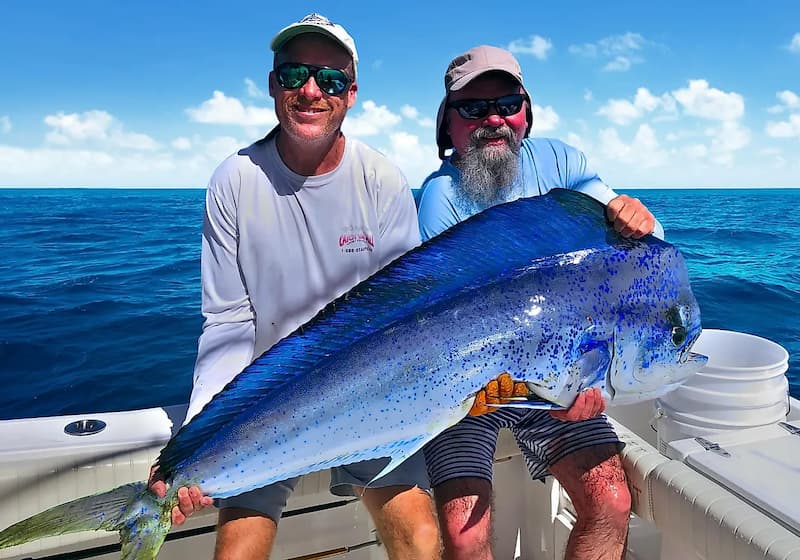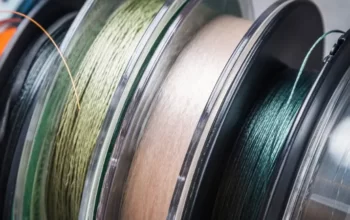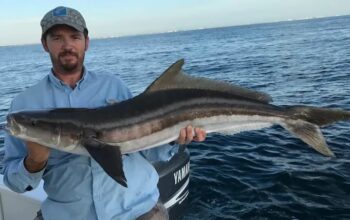To start with, what is deep sea fishing?
An excursion into the deep waters of the Atlantic Ocean and up the Intercoastal Waterway is necessary for deep sea fishing, which takes place far from land. To qualify as a deep sea fishing area, the water must be at least 30 meters deep. If you tend to get seasick when traveling by boat, prepare in advance and have the right medication on hand. Large game fishing, sport fishing, or offshore fishing are common names for this method of fishing.
For more information, continue reading.
Table of Contents
What Is Deep Sea Fishing?
Most people refer to any type of recreational fishing conducted in ocean waters at depths lower than 100 feet as deep sea fishing. Although commercial fishing vessels frequently fish at these depths, that type of deep sea fishing will not be covered in this article.
Deep water fishing does not include any types of freshwater or saltwater bay fishing. deep sea fishing is always carried out from a boat because the deep seas are by their very nature remote from land. Boats can occasionally travel to deep sea depths relatively close to land. Other times, this kind of fishing is done dozens or even hundreds of miles from the closest land.
This kind of fishing is also known as trophy or sports fishing by some fishermen.
Deep Sea Fishing Types
Most fishermen who go deep sea fishing do so with the assistance of guiding service. The location, guide service, and fish species all affect the price of these fishing charters. deep sea fishing isn’t for inexperienced sailors, that much is clear. Even the nicest boats are frequently rocked by the open ocean’s large, rolling waves. Even the most robust anglers can become queasy when all they can see is water. You can choose a deep sea fishing charter as a private charter or as part of a group.
During a deep sea fishing trip, guides frequently allow their clients to test out different fishing techniques. Trolling, chumming, popping, and jigging are a few of these techniques. Anglers who use trolling often use live bait and dangle their lines behind a boat that is moving quickly. Bait is tossed onto the water during chumming in an effort to draw deep sea fish to the surface. Jigging is a style of lure fishing where the lure is attached to a lead weight that causes it to dance in a specific pattern deep underwater. These jigs are typically cast by fishermen while drifting along at various depths. Popping is a less common method of deep sea fishing. It entails using larger lures called “poppers” that slap the water to make sounds that attract nearby fish.
Half-day Trips
Typically, a half-day tour is the most affordable choice for sport fishing excursions. These shorter tours typically don’t venture too far from the shore because it takes a while to travel very far out into the ocean.
Full-day Trips
Trophy fishing frequently involves full-day excursions. These charter boats depart the shore in the early morning and occasionally come back after dusk. A better opportunity to experiment with various deep sea fishing techniques is provided by multi-day excursions for anglers.
Night Fishing Adventures
Only at night do certain types of fish bite. Some fishing guides offer deep sea tours at night in order to catch these fish.
Multi-day Excursions
The best of the best are these deep sea fishing expeditions. They are the priciest but also provide the most opportunities despite the cost. Fishermen can anticipate using a variety of techniques at various times of the day. The best chance for anglers to land their ideal fish is with this variety.
Mahi-mahi, also known as dorado, is an exciting deep sea fish to catch. Pixabay image by Lisa Larsen.

What Kind Of Fish Will I Be Pursuing?
Big game species are the main focus of deep sea fishing for many fishermen. These are sizable saltwater fish that, when hooked at the end of a line, fight fiercely and aggressively. Targeting them is primarily done for fun and to experience the rush of adrenaline that comes from facing off against a creature from deep water. In addition to battling ferocious reef fish, deep sea fishing may involve searching the ocean’s bottom for bottom fish.
A brief list of some of the most popular targets is provided below:
- Billfish. Possibly the most well-known deep sea fish species. Around the world, there are numerous members of this fish family. Due to their recognizable appearance and fierce fighting spirit, they are the ultimate prey for ambitious sport anglers.
- Tuna. The main focus of deep sea tuna fishing is on yellowfin and bluefin tuna. Bluefin tunas have the potential to get quite large and are known for their aggressive deep dives. The strongest fighters in the ocean, pound for pound, are yellowfin. Additionally, they are both incredibly delicious.
- Other pelagics. For good reason, the top deep sea fishing targets are frequently Mahi Mahi and Wahoo. They are entertaining to chase, grow to impressive sizes, and engage in impressive combat when hooked.
- Sharks. Although these toothy predators are well-known all over the world, deep sea fishing frequently ignores them. The stringent guidelines that surround them are the cause of this. Deep sea fishing frequently involves pursuing Porbeagle Sharks off the coast in some places, like Massachusetts. Thresher Sharks are found in the canyons close to California.
- Reef species. Although they might not come to mind when thinking of deep sea fishing, reef-dwelling fish like amberjack, cobia, and barracuda offer excellent angling action. They can be located in 250-foot-deep water. They’re the ideal prey for beginning deep sea anglers because they still give you a good workout without leaving you with sore muscles like a marlin can!
- Snapper. Red snapper, in a nutshell. When the federal fishing season starts, these fish incite a frenzy in anglers that is unmatched by almost any other species. Why? Because this is the best time to hook Reds that weigh between 20 and 30 pounds. It’s simple to understand the commotion. They have great flavor and provide great game action.
- Grouper. Grouper, which can reach enormous sizes, is frequently targeted during the same deep sea expeditions as Snapper. After all, there’s a good reason why one variety of grouper is known as the “Goliath.” These fish are plentiful, delicious, and they also make for some surprisingly good angling action. Consider making deep runs near the ocean’s bottom and around wrecks and reefs.
Fish that migrate and live in different waters at different times of the year are a common target of deep sea fishing, especially for big game species. Because of this, deep sea fishing can be a pretty seasonal activity. As a result, it’s imperative that you become familiar with the movements of your target fish and the times when they are present nearby. Fishing on a charter becomes useful in this situation. You can learn more about the whereabouts of your target species from your captain.
Methods For Deep Sea Fishing?
Trolling
For big game species like billfish and tunas, this is the preferred deep sea fishing method. Trolling basically entails using a moving boat to drag hooked lures or bait through the fishery of your choice. You’ll typically set up two to six rods, meaning you’ll be trolling at least two to six lines, most of which will be weighted, depending on the boat you’re fishing from. With the ability to target various water depths, you can cover a lot of ground.
Your captain’s method for doing this? using both downriggers and outriggers effectively. Outriggers extend from the boat, allowing you to cast more lines and space your bait farther apart. Downriggers use heavy weights attached by a clip to lower your bait to deep sea levels without tangles. When the fish bites, the clip separates, and the game begins.
You can choose the appropriate gear with the assistance of your captain, who will typically have a wide variety of rods, reels, and tackle set up on board. Your choice of target will also determine the type of bait you use, but many trolling anglers favor live or cut dead bait. They do so by emitting a scent, and the fresher, the better. Popular choices include mackerel, squid, ballyhoo, mullet, and ballyhoo.
Bottom Fishing
Bottom fishing is the best method for finding large, delicious fish that hide out near deepwater reefs and wrecks. Nearshore waters frequently employ this tactic. Naturally, the fishing grounds you’ll be visiting on your trip are much deeper, necessitating some modifications.
Your boat should be anchored or drifting over areas where fish are known to hide out if you want to go bottom fishing. It’s a versatile technique that basically just entails placing your lure or bait near the ocean floor or even directly on top of it, then watching for fish to bite. In order to imitate bait fish, you can also use techniques like bottom bouncing, which involves dragging your bait along the bottom of the waterway.
A hook, line, sinker, and bait are typically used in a bottom fishing setup, which is typically quite straightforward. Again, your captain will have the appropriate equipment on board for you. A good variety of different weighted lines and sinkers will typically be used for this. Although learning to fish from the bottom is simple, keep in mind that you’ll be doing so in rocky terrain. As a result, fish may escape and lines may break. Practice makes perfect, as it does with the majority of skills.
Deep Dropping
Baits are dropped very, very deep—exactly as it sounds—by a technique called “deep dropping.” This method will be used in waters that are at least 300 feet deep, where you will come across deep sea creatures like the powerful Swordfish. Anglers looking to stock their freezers with delicious Snapper and Grouper varieties also enjoy it.
Although deep dropping and bottom fishing are similar, deep dropping is different because of the depths of the water you’ll be fishing in and the gear you’ll need. When a large fish decides to bite, your captain will typically need to use specialized electric deep-dropping reels that can hit the ocean floor and bring it to the surface. Typically, a heavy 130–200 lb braided fishing line will be used with this reel because it is less likely to break.
There are two crucial aspects to think about when choosing bait: scent and staying power. After all, your chosen bait should be able to withstand being submerged for at least a few hundred feet while still luring your desired fish. Popular options include chunks of squid, barracuda, and bonito.
How To Prepare A Deep Sea Fishing?
Preparation is needed before boat fishing. This is particularly true for deep sea fishing expeditions, where you will be far from land and the weather can change in a matter of minutes. What we have for you as advice is listed below:
- Think carefully about what to wear. The weather greatly affects what you should wear when deep sea fishing. In the summer, a good baselayer shirt with good breathability should be worn under a light, long-sleeved shirt with UPF protection. Add a warm layer during the colder months, such as a fleece jacket or waterproof coat. To prevent slipping, choose non-skid shoes with rubber soles. Lastly, dress in clothing that you don’t mind getting dirty. You’ll probably get blood, fish slime, and saltwater on your clothes. The best option is to wear fishing attire that is waterproof and stain-resistant.
- Ahead of time, check the weather. Only if you are unprepared can bad weather ruin a fishing trip more than anything else. Make sure to pack weather protection such as sunglasses, a buff (a specialized fishing mask), a hat, and sunscreen. Before your trip, check the forecast.
- Bring drinking water. On a deep sea fishing trip, you can never have enough drinking water even though there is a good chance that your captain will already have water on board. You should stay well-hydrated because this type of fishing requires a lot of work, especially when taking into account the long travel time. If there aren’t any snacks on board, ask your captain if it’s ok to bring some. Fishing is grueling labor!
- Never forget your seasickness medicine. Do you believe that you never get seasick? You might reevaluate this after going deep sea fishing. Even the toughest fishermen can suffer from a long (or even brief) voyage out on choppy waters. Make sure the only thing spinning is the reels by bringing Dramamine or another similar anti-motion sickness medication!
Deep Sea Fishing Suggestions
- Be One With Nature. Your deep sea fishing guide in Myrtle Beach has the experience to spot clues to the location of the big fish that a novice might miss. You are probably aware that seeing seagulls circling over an area is a good sign that smaller fish, the seagulls’ primary food source, are present. Smaller fish schools indicate the presence of larger fish nearby.
- When Fishing For Tuna, Beware of Dolphins Since these two species of marine life frequently gather in schools, dolphins frequently mark tuna. As a protected species, dolphins must not be harmed.
- Fish Near A Reef The big fish travel to the reef to feed because it is home to many smaller fish. A gold mine may exist here.
- Motion Sickness. As we previously mentioned, this is something to think about if you are a novice who has never gone fishing. The journey is supposed to have a thrilling and satisfying outcome. If you are prone to movement sickness, it will end up being very different from what you had anticipated. You can treat some of the symptoms with medication, but if you are really susceptible, you should reconsider going deep sea fishing.
- Choose Experts. Having a knowledgeable deep sea fishing guide on board is a good idea. Since deep sea fishing is a more dangerous activity than recreational fishing exploration, beginners to the sport should always travel in a group. You have the choice of traveling in a group or renting a boat exclusively for you and your friends at Voyager Deep Sea Fishing.
- Full Time Deck Hands Needed Immediately (1525 13th Ave North) Onboard sport fishing charters and party fishing boats, full-time deck hands are urgently needed.
The Bottom Line
Deep sea fishing, also known as sport or big game fishing, is a method of angling for large open-ocean fish species like swordfish, shark, and tuna. This kind of fishing is meant to be enjoyable because it can be difficult to catch big game fish, and depending on whether people keep or release their catch, it can also be a food source. Many parts of the world engage in deep sea fishing, and if you are traveling to or residing in a coastal area, it is frequently possible to charter a boat for sport fishing.
I hope this blog was enjoyable for you and that it gave you some insight into what deep sea fishing is. Please leave a comment in the space provided below the blog post if you have any questions, and I will be happy to assist you.




